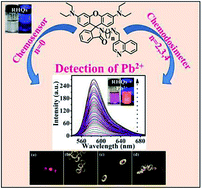A series of highly selective and sensitive fluorescent turn-on probes, RHQs 1–4, for the toxic heavy metal ion Pb2+ have been developed based on rhodamine–quinoline conjugates. In these probes, the length of the spacer chain between the rhodamine and quinoline subunits plays important roles in deciding their sensitivity as well as the detection mechanism. By modulating the number of carbons in the spacer from n = 0 to n = 4, the sensitivity of the probes could be altered between 3 μM and 17.4 nM. Moreover, by changing the number of carbons in the spacer from 0 to higher numbers, the detection mechanism of these probes could also be changed from normal fluorescent chemosensing to chemodosimetry. Plausible mechanisms for the chemosensing and chemodosimetry exhibited by these probes have been proposed, which are supported by NMR and HR-MS studies as well. RHQ-1 exhibited reversible complexation and decomplexation behaviours on alternate additions of Pb2+ and CH3COO− ions, respectively, accompanied by fluorescence ON–OFF switching. This property revealed its potential towards the construction of an INHIBIT-type molecular logic gate. RHQs 1–4 exhibited potential for detecting Pb2+ in tap water samples as well as in biological systems.

